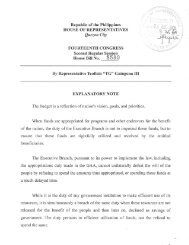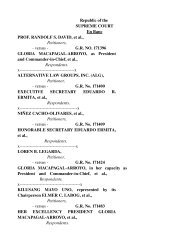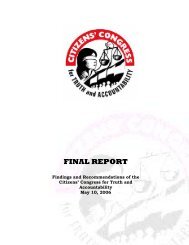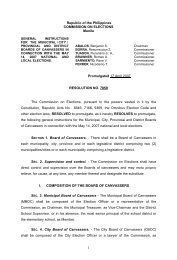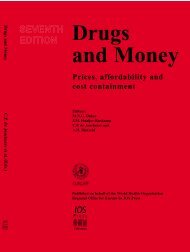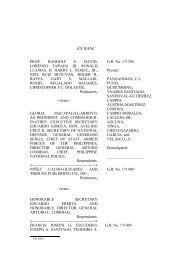Decentralization and Corruption in the Philippines
Decentralization and Corruption in the Philippines
Decentralization and Corruption in the Philippines
You also want an ePaper? Increase the reach of your titles
YUMPU automatically turns print PDFs into web optimized ePapers that Google loves.
with kickbacks passed up to <strong>the</strong> Presidency. Much of <strong>the</strong> corruption <strong>in</strong> <strong>the</strong> Philipp<strong>in</strong>es<br />
does appear to be at <strong>the</strong> local level, of <strong>the</strong> 336 impend<strong>in</strong>g corruption cases, 49% are<br />
aga<strong>in</strong>st municipal mayors- <strong>the</strong> level of government which is our focus <strong>in</strong> this study<br />
(Batalla 2000). Many observers have stated that corruption is <strong>the</strong> root cause of cont<strong>in</strong>ued<br />
poverty <strong>in</strong> <strong>the</strong> Philipp<strong>in</strong>es. All this makes our study of local level corruption <strong>in</strong> <strong>the</strong><br />
Philipp<strong>in</strong>es highly relevant <strong>in</strong> a country specific context.<br />
In addition studies such as this one might have global relevance <strong>in</strong> terms of <strong>the</strong><br />
<strong>in</strong>creas<strong>in</strong>gly important question of <strong>the</strong> determ<strong>in</strong>ants of local government performance <strong>and</strong><br />
<strong>the</strong> effect of corruption on health service delivery. However, we acknowledge <strong>the</strong><br />
difficulty of generaliz<strong>in</strong>g from one possibly unrepresentative country, <strong>and</strong> would prefer to<br />
replicate this study <strong>in</strong> o<strong>the</strong>r countries with a large number of local governments before<br />
mak<strong>in</strong>g global prescriptions.<br />
It is important to po<strong>in</strong>t out one related question that our study does not answer: <strong>the</strong><br />
impact of decentralization on corruption. The decentralization <strong>in</strong> <strong>the</strong> Philipp<strong>in</strong>es did<br />
co<strong>in</strong>cide with an improvement <strong>in</strong> corruption assessments by <strong>the</strong> International Country<br />
Risk Guide produced by Political Services International (Figure 1), but this could be due<br />
to any number of reasons (<strong>the</strong>re was also a change of government around this time), <strong>and</strong><br />
its difficult to say anyth<strong>in</strong>g more. There is reportedly more corruption at <strong>the</strong> national<br />
level accord<strong>in</strong>g to our respondents –<strong>the</strong> most reliable respondents for this comparison<br />
may be private school pr<strong>in</strong>cipals (Table 1)- but this could easily be due to <strong>the</strong>re be<strong>in</strong>g<br />
more opportunities for corruption at <strong>the</strong> national level which controls more than 80% of<br />
Philipp<strong>in</strong>e f<strong>in</strong>ances. As we can see <strong>in</strong> Figure 2, <strong>the</strong> extent of authority <strong>in</strong> different<br />
branches of government does correspond with levels of corruption, though <strong>the</strong> extremely<br />
small sample size does not allow any authoritative statements. We exam<strong>in</strong>e this issue<br />
below <strong>in</strong> some detail us<strong>in</strong>g variation across municipalities.<br />
This paper is structured as follows. We beg<strong>in</strong> by describ<strong>in</strong>g <strong>the</strong> data. In particular<br />
we exam<strong>in</strong>e <strong>in</strong> detail <strong>the</strong> quality of <strong>the</strong> data on corruption <strong>and</strong> are reassured by a number<br />
of correlations across samples. The corruption perceptions of households, municipal<br />
adm<strong>in</strong>istrators <strong>and</strong> municipal health officers are all correlated with each o<strong>the</strong>r <strong>and</strong> <strong>the</strong><br />
3 The large discrepancy between <strong>the</strong> 40% revenue allotments <strong>and</strong> <strong>the</strong> 12.6% of devolved expenditures can<br />
be expla<strong>in</strong>ed <strong>in</strong> part by <strong>the</strong> three-year lag <strong>and</strong> unbalanced budgets.<br />
3



